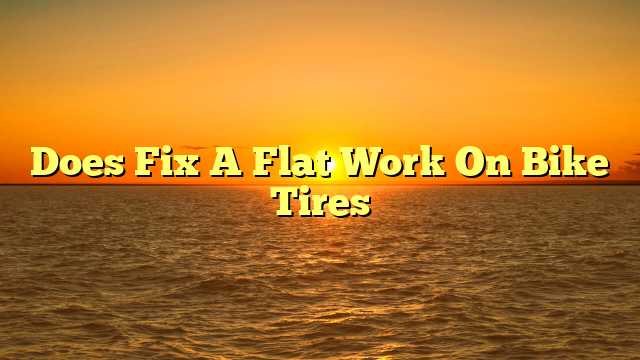
Riding a bike with a flat tire can be a tempting option when you don’t have the time or the means to fix it.
However, it is crucial to understand the potential dangers and risks associated with this decision.
Riding with a flat tire can have significant effects on bike control and may result in severe damage to your bike.
In this article, we will explore the various aspects of riding with a flat tire and provide you with a detailed analysis of its effects on your bike and your safety.
We will discuss the potential dangers and risks associated with riding on a flat tire, as well as the circumstances under which it is safe to do so.
We will also provide you with tips and guidelines on how to assess your tire’s condition, repair or replace it, and prevent future flat tires.
Table of Contents
- 1 Key Takeaways
- 2 The Dangers of Riding with a Flat Tire
- 3 Effects on Bike Control
- 4 Potential Bike Damage
- 5 When It’s Safe to Ride with a Flat Tire
- 6 How to Assess Your Tire’s Condition
- 7 Tips for Handling a Flat Tire on the Road
- 8 Repairing vs. Replacing a Flat Tire
- 9 Preventing Flat Tires in the Future
- 10 Frequently Asked Questions
- 10.1 How often should I check my bike tires for wear and tear?
- 10.2 Can I use a temporary bike tire patch to fix a flat tire on the road?
- 10.3 What are some common causes of flat tires on bikes?
- 10.4 Is it better to replace both tires if one of them is flat?
- 10.5 Are there any special tools or equipment I need to carry with me in case of a flat tire while riding?
- 11 Conclusion
Key Takeaways
- Riding with a flat tire is dangerous and can cause loss of control and damage to the bike.
- Proper tire pressure and regular checks can prevent flat tires.
- Riding with a flat tire causes physical strain and decreases performance.
- Handling a flat tire on the road requires proper equipment and knowledge, and cyclists should be prepared to call for roadside assistance if necessary.
The Dangers of Riding with a Flat Tire
Riding a bike with a flat tire can pose serious safety risks.
The first and most obvious risk involved is the loss of control.
When a tire is flat, it becomes significantly harder to steer and maneuver the bike, which can result in accidents and injuries.
Additionally, a flat tire can decrease the stability of the bike, making it more difficult to ride on uneven terrain or at high speeds.
This can cause the rider to lose balance and fall, potentially causing serious harm.
Another risk involved in riding with a flat tire is potential damage to the wheel rim.
When the tire is flat, the rim is exposed to more pressure and friction, which can cause it to become scratched or damaged.
This not only affects the appearance of the bike but can also lead to more serious problems, such as rust or corrosion, which can weaken the wheel and make it more prone to failure.
It is essential, therefore, to maintain your bike regularly and ensure that the tires are properly inflated before each ride.
By doing so, you can reduce the risks involved in riding with a flat tire and ensure a safer, more enjoyable biking experience.
Effects on Bike Control
The impact of a deflated tire on the stability and maneuverability of a bicycle has been extensively studied in the field of biomechanics.
Improper handling of a bike with a flat tire can result in a decrease in stability and control, leading to an increased risk of accidents.
The deflated tire can cause the bike to wobble, making it difficult to maintain balance and control, particularly at high speeds.
The reduced air pressure may also affect the bike’s handling, making it harder to steer and turn.
Riders may need to adjust their body position to compensate for the compromised stability, placing additional physical strain on the body.
The physical strain associated with riding a bike with a flat tire can also affect the rider’s performance.
The increased effort required to maintain control can result in a decrease in endurance, leading to fatigue and reduced performance over longer distances.
The reduced stability of the bike can also increase the risk of injury, particularly for riders who engage in more extreme maneuvers such as jumps or tricks.
In summary, the impact of a deflated tire on bike control can be significant, requiring riders to take extra precautions to ensure their safety and performance.
Potential Bike Damage
One potential consequence of inadequate inflation levels in a bicycle’s tire is the possibility of causing damage to the bike itself.
When a tire is ridden with low pressure, it can cause excessive wear and tear on the tire itself, leading to premature failure.
Additionally, the rim of the wheel can become damaged due to the increased stress placed on it when the tire is not properly inflated.
This can lead to costly repairs and even the need to replace the entire wheel.
Proper tire pressure is also crucial in preventing punctures.
When a tire is underinflated, it is more susceptible to punctures from debris on the road.
The lack of pressure means that the tire is not able to withstand the impact of small objects such as rocks or glass, which can lead to punctures.
Regularly checking and maintaining proper tire pressure can help prevent these types of damage and prolong the life of the bike.
When It’s Safe to Ride with a Flat Tire
Continuing to pedal with a deflated tire can result in a bumpy and jarring ride, causing instability and potential loss of control.
Riding a bike with a flat tire can also cause damage to the rim, which can lead to costly repairs.
Despite this, there are some situations where it may be safe to ride with a flat tire.
Here are three factors to consider before deciding whether to ride with a flat tire:
- Riding technique: Experienced riders who are comfortable with maneuvering a bike can often compensate for a flat tire by shifting their body weight and adjusting their pedaling technique.
However, inexperienced riders may struggle to maintain balance and control, putting themselves at risk of injury.
- Tire pressure management: A flat tire can be caused by a puncture, a valve leak, or simply low tire pressure.
If the cause of the flat tire is a puncture or a valve leak, it is not safe to ride with the tire until it is repaired or replaced.
However, if the tire pressure is just low, it may be possible to temporarily inflate the tire and ride it to a safer location.
- Distance and terrain: The distance you need to travel and the type of terrain you will encounter are also important factors to consider.
Riding with a flat tire on a smooth, flat surface for a short distance may be feasible, but attempting to traverse rough or hilly terrain is not recommended.
In general, it is best to avoid riding with a flat tire if possible.
Regular tire pressure checks and maintenance can help prevent flats from occurring in the first place.
If you do find yourself with a flat tire while riding, assess the situation carefully and make a decision based on your experience level, the cause of the flat, and the conditions you will be riding in.

How to Assess Your Tire’s Condition
Assessing the condition of a bicycle tire is an essential element of bike maintenance, requiring careful attention and a systematic approach.
Two critical aspects to consider when assessing a tire’s condition are tire pressure and tread wear.
Tire pressure impacts the quality of the ride, the stability of the bike, and the likelihood of a flat tire.
Treadwear, on the other hand, affects the tire’s grip on the road, especially in wet or slippery conditions.
To assess tire pressure, use a tire pressure gauge to check the tire’s pressure against the recommended level indicated on the sidewall of the tire.
It is important to check tire pressure regularly, as underinflated tires can cause sluggish handling and increase the risk of a flat, while overinflated tires can make the ride bumpy and reduce the tire’s lifespan.
Tread wear can be assessed by examining the tire’s surface for any signs of wear, such as uneven wear patterns, bald spots, or punctures.
If the tread is worn too much, it is time to replace the tire, as it can no longer provide adequate traction.
By regularly assessing tire pressure and tread wear, cyclists can ensure the safety and longevity of their bike tires.
| Tire Pressure | Recommended Level | Impact |
|---|---|---|
| Underinflated | Below recommended level | Sluggish handling, increased risk of flat |
| Overinflated | Above recommended level | Bumpy ride, reduced tire lifespan |
| Properly inflated | Recommended level | Optimal ride quality, longer tire lifespan |
| Tread Wear | Signs of Wear | Impact |
|---|---|---|
| Uneven wear patterns | Traction loss, instability | Unsafe ride |
| Bald spots | Traction loss, increased risk of flat | Unsafe ride |
| Punctures | Air loss, increased risk of flat | Unsafe ride |
| Adequate tread | Even wear, no bald spots or punctures | Optimal traction, safer ride |
Tips for Handling a Flat Tire on the Road
Handling a flat tire on the road is a common issue faced by cyclists, which requires proper equipment and knowledge to fix it efficiently.
To handle this emergency, the cyclist should first move to a safe location, away from traffic, and evaluate the extent of the damage.
It is essential to carry a spare tube, a pump, and tire levers to fix the flat tire.
The cyclist should remove the wheel from the bike, detach the tire from the rim, and replace the damaged tube.
After inserting the new tube, the cyclist should inflate the tire to the recommended pressure and reattach the wheel.
In some cases, handling a flat tire on the road may not be possible, and the cyclist may require roadside assistance.
Cyclists should be aware of the availability of roadside assistance in their area and be prepared to call for help if necessary.
In such situations, the cyclist should move to a safe location, preferably off the road, and wait for assistance to arrive.
It is crucial to have a charged mobile phone and to provide accurate information about the location and the nature of the problem to the service provider.
With proper handling of a flat tire emergency, cyclists can continue to enjoy their ride safely.
Repairing vs. Replacing a Flat Tire
In the previous subtopic, we discussed tips for handling a flat tire on the road.
Now, let’s delve deeper into the topic of repairing versus replacing a flat tire.
When faced with a flat tire, the first instinct for many is to replace it.
However, patching the tire can be a viable option.
Here are some things to consider when deciding whether to patch or replace a flat tire:
- The severity of the damage: If the damage is minor, such as a small puncture, patching the tire can be a cost-effective solution.
However, if the damage is severe or in a location that cannot be patched, such as on the sidewall, replacing the tire is the only option.
- Age of the tire: If the tire is relatively new and in good condition, it may be worth patching instead of replacing.
However, if the tire is old and nearing the end of its lifespan, it may be more cost-effective to replace it rather than invest in a patch.
- Cost Comparison: Generally, patching a tire is less expensive than replacing it.
However, the cost of the repair versus the cost of a new tire may vary depending on the severity of the damage and the age of the tire.
It’s important to weigh the costs and benefits of each option before making a decision.
Ultimately, whether to patch or replace a flat tire depends on several factors.
By considering the severity of the damage, the age of the tire, and the cost comparison, you can make an informed decision that ensures the safety and reliability of your vehicle.
Preventing Flat Tires in the Future
Effective tire maintenance practices can significantly reduce the likelihood of experiencing a sudden tire failure while driving.
Regular maintenance involves checking the tire pressure, alignment, and condition of the tires.
One of the most important aspects of tire maintenance is maintaining the correct tire pressure.
Low tire pressure can cause the tire to wear unevenly or overheat, which can lead to a blowout.
On the other hand, overinflated tires can result in reduced traction and a bumpy ride.
Thus, it is crucial to maintain the recommended tire pressure as specified in the vehicle owner’s manual.
In addition to maintaining the correct tire pressure, regularly checking the tires for wear and damage can prevent sudden tire failure.
Over time, tires wear down and may develop cracks or punctures, making them more susceptible to failure.
Inspecting the tires for damage and replacing them as necessary can prevent a flat tire from occurring while driving.
It is also essential to ensure that the tires are properly aligned.
Misaligned tires can cause uneven wear and affect the vehicle’s handling, leading to a potential accident.
Therefore, by regularly monitoring the tire pressure, inspecting the tires for damage, and ensuring proper alignment, drivers can minimize the risk of experiencing a flat tire while driving.
Frequently Asked Questions
How often should I check my bike tires for wear and tear?
Regularly checking your bike tires for wear and tear and proper pressure is crucial for safe and efficient cycling.
Signs of wear and tear include cracks, punctures, and worn treads.
Proper tire pressure ensures optimal performance and reduces the risk of flats.
Can I use a temporary bike tire patch to fix a flat tire on the road?
Temporary patches can be a quick and easy solution to fix a flat tire on the road.
However, they come with potential downsides such as decreased reliability and durability.
Proper application, including cleaning the area and ensuring a secure seal, is crucial for optimal performance.
What are some common causes of flat tires on bikes?
Flat tires on bikes are commonly caused by punctures and pinched tubes.
Proper tire maintenance and inflation can help prevent these issues.
Examining the tire for debris and regularly checking the pressure can aid in avoiding flat tires while riding.
Is it better to replace both tires if one of them is flat?
Replacing only one tire on a bike is acceptable.
However, it may lead to uneven wear and affect the bike’s handling.
Riding on a flat tire can cause damage to the bike’s rim and increase the risk of accidents.
Are there any special tools or equipment I need to carry with me in case of a flat tire while riding?
Bike tire repair necessitates carrying a tire lever, patch kit, and portable pump.
Portable pump options include hand pumps, CO2 cartridges, and electric pumps.
These tools enable cyclists to repair a flat tire on the go without requiring assistance.
Conclusion
In conclusion, riding a bike with a flat tire is highly discouraged due to the potential dangers it poses.
It affects the rider’s control over the bike and can cause significant damage to the bike itself.
Before riding, it is essential to assess the tire’s condition and ensure that it is safe for use.
In the event of a flat tire on the road, it is crucial to handle the situation carefully.
This involves safely stopping the bike, assessing the tire, and deciding whether to repair or replace it.
Preventing flat tires in the future requires regular maintenance, such as checking tire pressure and avoiding rough terrain.
By following these guidelines, riders can ensure the safety and longevity of their bike.
Useful Links:







